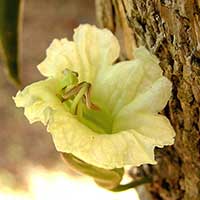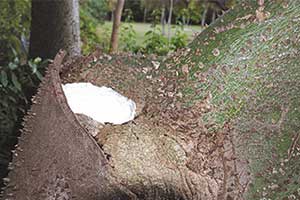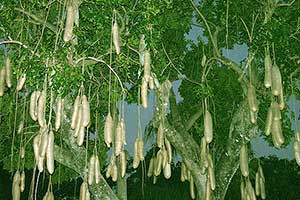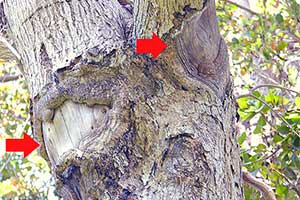
Pollination and the Natural History of the Calabash Tree

An unusual tree occasionally found growing in South Florida gardens is the Calabash tree, Crescentia cujete. This relative of the Sausage Tree occurs naturally from Mexico to Brazil including the Antilles. It can be immediately recognized by the large, round green fruit attached directly to the branches of the tree. An otherwise undistinctive tree, it is usually overlooked unless in fruit.
The Calabash is also fairly cold sensitive and will be damaged by even a moderate frost. Calabash flowers bloom at night and are white or light brown. The flowers are attached directly to the trunks and branches of the tree where they are visited by bats, moths, and many species of insects seeking the nectar within each flower. The flowers are self-compatible. This means that a flower can pollinate itself if an animal or insect moves the pollen from the stamen (male part of the flower) to the pistil (the female part of the flower) at the appropriate time. Here in South Florida, ants seem to be a common pollinator. Successful pollination can also be done by hand.
Since Calabash flowers are self-compatible, pollen doesn’t have to be collected beforehand or even from another tree. Once the flowers open in the evening and the stamens begin to show their pollen, the pollen can be utilized for that flower or any other Calabash flower. The corolla (the flower petals collectively), with the stamens eventually drops off during the night leaving only the pistil still attached to the ovary. Even in the early morning after the corolla has fallen off, the pollen can be used if it is still dry. It is important to note that the pistil must be open and dry to be receptive to the pollen. The pistil is receptive only one night and normally closes an hour or so after sunrise. Also, fruit set is not guaranteed even under the best conditions and many newly formed fruit seem to abort after only a few days.
It is always prudent to pollinate over a period of several weeks and since the Calabash blooms sporadically throughout the year, pollination should be done at different times. Once the fruit has matured, it can last on the tree for five or six months.
As the young fruit are developing, an interesting relationship takes place with certain species of ants. There are tiny nectar glands or nectaries on the fruit that exude a liquid that attracts ants for its food value. The ants in turn help protect the new fruit from predators that might eat or damage it (Elias 1978). This type of relationship is a form of Symbiosis, where the relationship benefits one or both partners. In this case both the ants and the fruit benefit from the relationship. As the fruit matures the nectaries gradually disappear.
The fruit has a hard outer shell and is not palatable; very few animals are known to eat them with no ill effects, mainly horses (Janzen 1983). The pulp of the fruit contains hydrocyanic acid and is considered a purgative; it is toxic to birds and small mammals (Lewis 1977). Ingesting the fruit can cause livestock to abort (Hoyos 1992). Because of the durability of the shell after it has dried and the many different sized fruit found on different trees, the Calabash fruit is used to make containers for holding food or water. It is also commonly used in Tropical American folk medicine.
The term cauliflory is used when the fruit or flowers of a tree grow directly onto the trunk. This characteristic is more common in species of tropical trees than temperate trees. Some other cauliflorous tropical trees are Theobroma cacao, (chocolate), Parmentiera cereifera, (Candlestick tree), and Ficus sur. Horticulturally speaking, the Calabash Tree makes a very interesting addition to any garden. A specimen tree can be grown when located in an area with full sun and protection from frost and freezing wind. It is also an excellent host for epiphytes; many species of bromeliads and orchids will thrive when attached to the branches and trunks.
Photo Gallery
Click Photos to Enlarge
More Articles
Elias, T.S. & G.T. Prance, 1978. Nectaries on the fruit of Crescentia and other Bignoniaceae. Brittonia 30(2): 175-181.
Hoyos, Jesus F., 1992. Totumo, Crescentia cujete, pp. 29-30 in Arboles Tropicales Ornamentales, Sociedad de Ciencias Naturales La Salle, Monografia 38, Caracas
Janzen, D.H., 1983. Crescentia alata, pp. 222-224 in Costa Rican Natural History. The University of Chicago Press
Lewis, Walter H. & Memory P.F. Elvin-Lewis, 1977. Medical Botany, Plants Affecting Man’s Health, John Wiley & Sons









 About Tropical Trees & Arboriculture
About Tropical Trees & Arboriculture An Experiment in Arboriculture and Mosquito Control
An Experiment in Arboriculture and Mosquito Control Ceiba Speciosa
Ceiba Speciosa Why Trees Blow Over
Why Trees Blow Over Royal Palm Bugs
Royal Palm Bugs Ficus Species & Hurricane Horticulture
Ficus Species & Hurricane Horticulture Pollination and the Natural History of the Calabash Tree
Pollination and the Natural History of the Calabash Tree Pollinating Sausage Trees
Pollinating Sausage Trees Some Observations on Relocating Tropical Trees
Some Observations on Relocating Tropical Trees